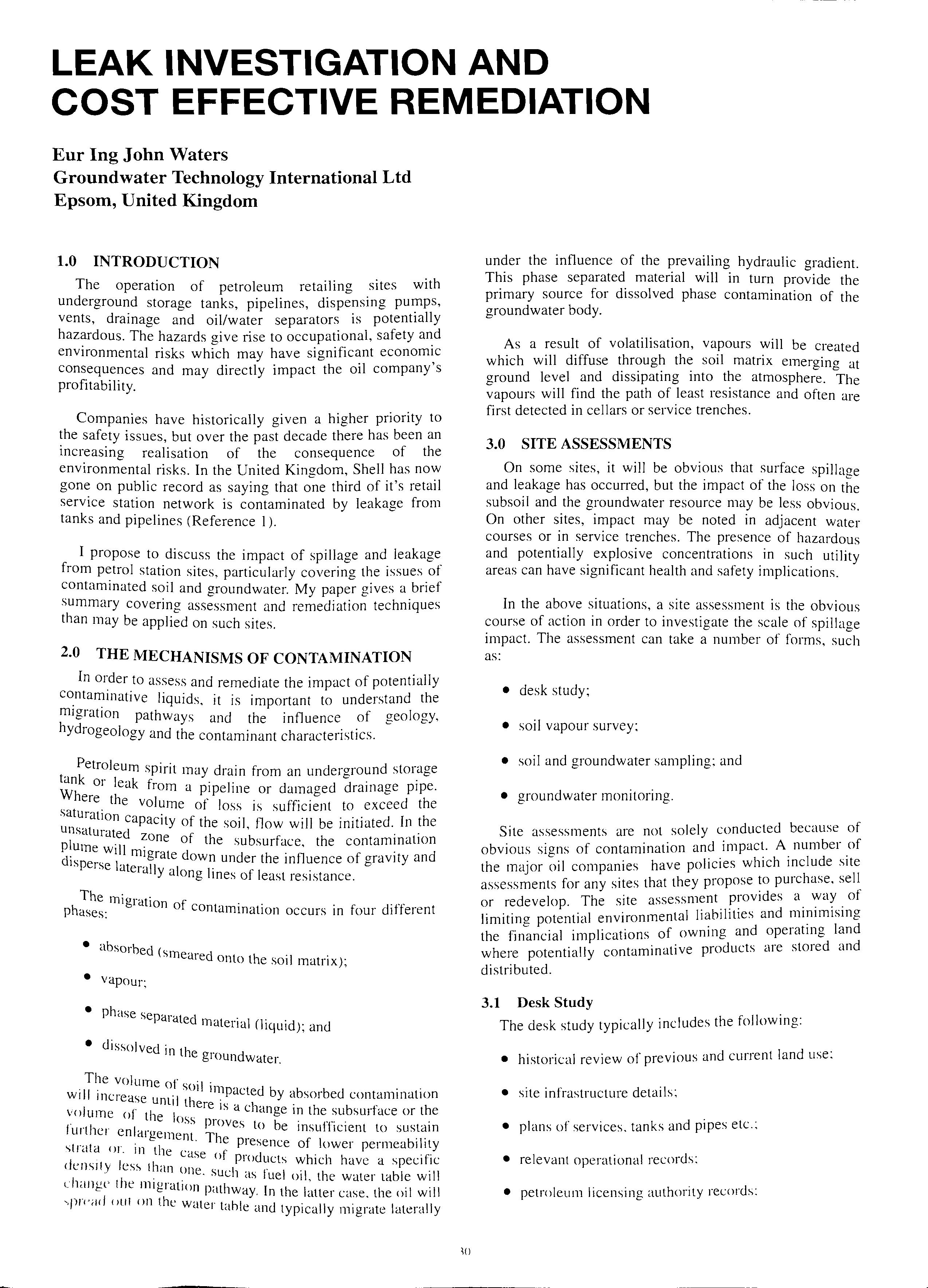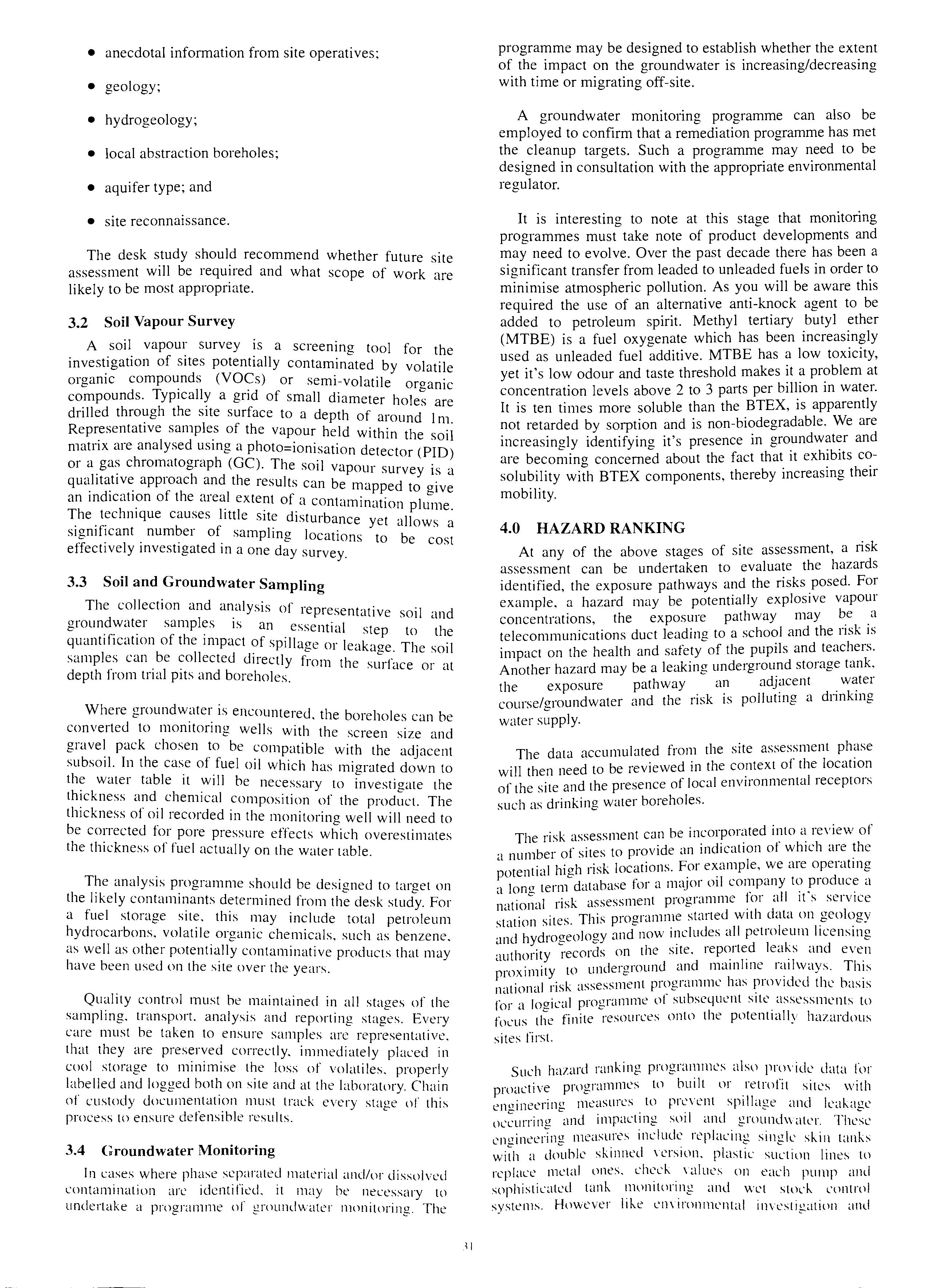
9 minute read
OVERFILL PREVENTION
by apeauk
LEAK INVESTIGATION AND COST EFFECTIVE REMEDIATION
Eur Ing John Waters Groundwater Technology International Ltd Epsom, United Kingdom
Advertisement
1.0 INTRODUCTION
The operation of petroleum retailing sites with underground storage tanks, pipelines, dispensing pumps, vents, drainage and oil/water separators is potentially hazardous. The hazards give rise to occupational, safety and environmental risks which may have significant economic consequences and may directly impact the oil company's profitability.
Companies have historically given a higher priority to the safety issues, but over the past decade there has been an increasing realisation of the consequence of the environmental risks. In the United Kingdom, Shell has now gone on public record as saying that one third of it's retail service station network is contaminated by leakage from tanks and pipelines (Reference 1 ).
I propose to discuss the impact of spillage and leakage from petrol station sites, particularly covering the issues of contaminated soil and groundwater. My paper gives a brief summary covering assessment and remediation techniques than may be applied on such sites.
2.0 THE MECHANISMS OF CONTAMINATION
In order to assess and remediate the impact of potentially liquids, it is important to understand the migrat10n pathways and the influence of geology, hydrogeology and the contaminant characteristics.
Petroleum spirit may drain from an underground storage or leak from a pipeline or damaged drainage pipe. . ere. the volume of loss is sufficient to exceed the capacity of the soil flow will be initiated. In the zone of the subsurface the contamination me disper will 1. mig t d ra e own under the . . mfluence . d of gravity an se aterally along lines of least resistance. The migratio phases: n f . . ° contammat1on occurs in four . different
• absorbed ( s . . · meaied onto the soil matrix); • vapour;
• phase separat d . e matenal Oiquid); and • dissolved in the . g1 oundwater. The volume ors will increase unrt · .1 . 1n:1Pacted by absorbed contamination volume of the 1 1 t .. ere is a change in the subsu1t'ace or the oss proves t b . 1·f· . . further enlarge · o e msu · 1c1ent lo sustam ment. The P . f .. slrala or. in the ea, resence o . tower I, " 1,. . se of products which have a spec1f1c 1 enslly ess than one s 1 r· . . · · uc 1 as uel oil the water table will cha11°e !he m1grat1on . tl . ' . . "' P<1 iway. In the latter case. the ml will out on the W'tle · t· bi d . . · ' ' <1. e an typically migrate laterally under the influence of the prevailing hydraulic gradient. This phase separated material will in tum provide the primary source for dissolved phase contamination of the groundwater body.
As a result of volatilisation, vapours will be created which will diffuse through the soil matrix emerging at ground level and dissipating into the atmosphere. The vapours will find the path of least resistance and often are first detected in cellars or service trenches.
3.0 SITE ASSESSMENTS
On some sites, it will be obvious that surface spillage and leakage has occurred, but the impact of the loss on the subsoil and the groundwater resource may be less obvious. On other sites, impact may be noted in adjacent water courses or in service trenches. The presence of hazardous and potentially explosive concentrations in such utility areas can have significant health and safety implications.
In the above situations, a site assessment is the obvious course of action in order to investigate the scale of spillage impact. The assessment can take a number of forms, such as:
• desk study;
• soil vapour survey;
• soil and groundwater sampling; and
• groundwater monitoring.
Site assessments are not solely conducted because of obvious signs of contamination and A. number .of the major oil companies have policies which mclude site assessments for any sites that they propose purchase, sell or redevelop. The site assessment provides a. of limiting potential environmental and m1?1m1smg the financial implications of ownmg and operatmg land where potentially contaminative products are stored and distributed.
3.1 Desk Study
The desk study typically includes the following:
• historical review of previous and current land use:
• site infrastructure details;
• plans of services. tanks and pipes etc.:
• relevant operational records:
• petroleum licensing authority records:
• hydrogeology;
• local abstraction boreholes;
• aquifer type; and
• site reconnaissance.
The desk study should recommend whether future site assessment will be required and what scope of work are likely to be most appropriate.
3.2 Soil Vapour Survey . A .soil. vapou~ survey !s a screening tool for the mvest.1gat1on of sites potentially contaminated by volatile orgamc compounds (VOCs) or semi-volatile oroa · d T · II · to me co.mpoun s. yp1ca ~ a gnd of small diameter holes are dnlled thro~gh the site surface to a depth of around 1 m. Representative samples of · I d · matnx are ana yse usmg a the vapour held withi th ·i n e soi photo=ionisation detector (PIO) or a gas . . chromatograph (GC). The so1'l \'apoLt . ·
· r su1 vey 1s a
qu<~htd~llv~ app1f·oahch and the results can be mapped to oive an m 1cat1on o t e areal extent of ·1 cont·1111· , t' 1 to • , • • • < < ma ion p ume. 1:he. t~chmque causes httle site disturbance yet allows a s1gmf1cant number of sampling ff . I . . . e ect1ve y mvest1gated ma one day Jocat1· . ons survey. t b o e cost
3.3 Soil and Groundwater Sampling The collection and analysis of represe t· t. . .1 . · n a 1ve soi and groundwater samples 1s an esse11t1 ·al ·t 'f' · f h · s ep to the quantt 1cat1on o t e impact of spillage or J k TI · i .. . . , . · ea age. le soi s<1mples can be collected directly fr<)m tl . t·· , d · · 1 · le sur <1ce or at epth Jrom tna pits and boreholes.

Where groundwater is encountered . . . converted to momtonng wells with the the t)). h l b < 1e o es can e s ·i·ee .... d . c n size an grave~ pack chosen ~o be compatible with the adjacent subsml. In the cas.e of .fuel oil which has migrated down to th~ water table it :-VIII be necessary to investigate the thickness a?d. chemical composition of the product. The thickness of 011 recorded in the monitoring well will need to be co~Tected for pore pressure effects which overestimates the thickness of fuel actually on the water table.
T~e analysis p~·ogramme should be designed to target on the _likely contammants d~termined from the desk study. For a luel storage site. this may include total petroleum hydrocarbons. volatile organic chemicals. such as benzene. as well as other potentially contaminative products that may have been used on the site over the years.
Quality control must he maintained in all stages of the sampling. transport, analysis and reporting stag~es. Every care must he taken to ensure samples are representative. that they are preserved correctly. immediately placed in cool storage to minimise the loss of volatiles. properly labelled and logged both on site and at the laboratory. Chai;1 of custody documentation must track every stage of this process to ensure defensible results.
3.4 Groundwater Monitoring
In cases where phase separated material and/or dissolved contamination arc identified. it may be necessary to undertake a programme of groundv.•ater monitoring. The
A groundwater monitoring programme can also be employed to confirm that a remediation programme has met the cleanup targets. Such a programme may need to be designed in consultation with the appropriate environmental regulator.
It is interesting to note at this stage that monitoring programmes must take note of product developments and may need to evolve. Over the past decade there has been a significant transfer from leaded to unleaded fuels in order to minimise atmospheric pollution. As you will be aware this required the use of an alternative anti-knock agent to be added to petroleum spirit. Methyl tertiary butyl ether (MTBE) is a fuel oxygenate which has been increasingly used as unleaded fuel additive. MTBE has a low toxicity, yet it's low odour and taste threshold makes it a problem at concentration levels above 2 to 3 parts per billion in water. It is ten times more soluble than the BTEX, is apparently not retarded by sorption and is non-biodegradable. We are increasingly identifying it's presence in groundwater and are becoming concerned about the fact that it exhibits cosolubility with BTEX components. thereby increasing their mobility.
4.0 HAZARD RANKING
At any of the above stages of site assessment, a risk assessment can be undertaken to evaluate the hazards identified, the exposure pathways and the risks posed. For example. a hazard may be potentially explosive vapour concentrations, the exposure pathway may be a telecommunications duct leading to a school and the risk is impact on the health and safety of the pupils and teachers. Another hazard may be a leaking underground storage tank. the exposure pathway an adjacent water course/groundwater and the risk is polluting a d1inking water supply.
The data accumulated from the site assessment phase will then need to be reviewed in the context of the location of the site and the presence of local environmental receptors such as drinking water boreholes.
The risk assessment can be incorporated into a review of a number of sites to provide an indication of which are the potential high risk locations. F.or e~ample, we are operat111g . 1 no ,1 o term database for a ma.1nr ml company to produce a
. II . . . t
. 0 ~ 1 . 1 1 1-1 ·s1- ·issessment pro<>ramme tor a 1t s service
na 1 1 , station . " sites. ' · · This • eo programme started . with data on .geology and hydrogeology and now i1.1cludes all petroleum licensing authority records on the site. rep<:rt~d leaks and even proximity to underground and mamhne railways. This national risk assessment programme has provided the basis for a logical programme of subsequent site. assessments to focus the finite resources onto the potentially hazardous sites first.
Such hazard ranking programmes alst1 prnvide data for proactive programmes to built nr re1rorit sites with engineering measures . to prL'Vent spillage and kakage occurrin~ and impal'lmg sod and groundwater. These enginec1ing measures include replaL·ing singk skin tanks wi~h a double skinned \ ersinn. plastic suL·t iun I ines to replace nlL'tal ones. check \ alues on each pump and sophistiL·a1ed tank monitoring and wet stoL·k nmtrol systems. However li"e L'nvirnnmcntal ill\L'stigation and


